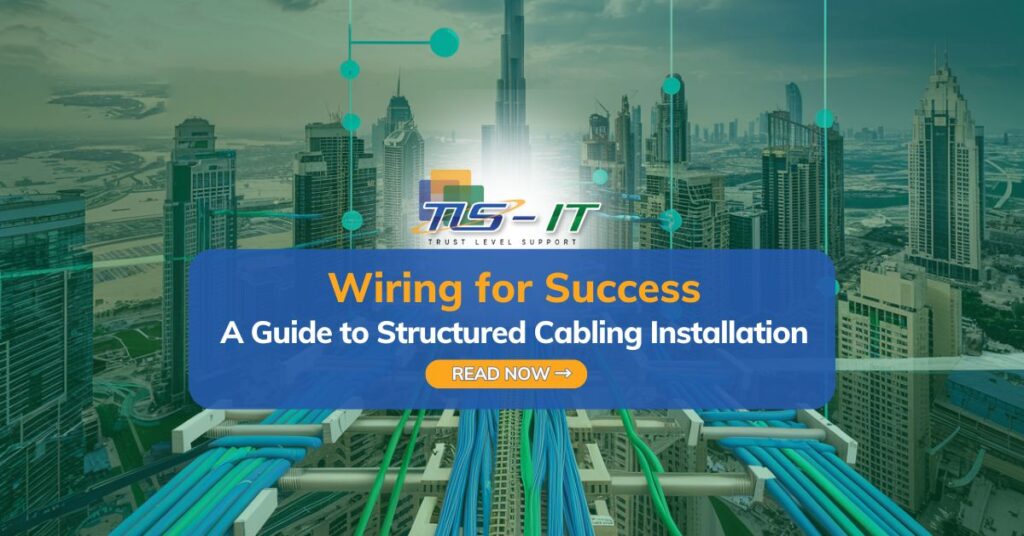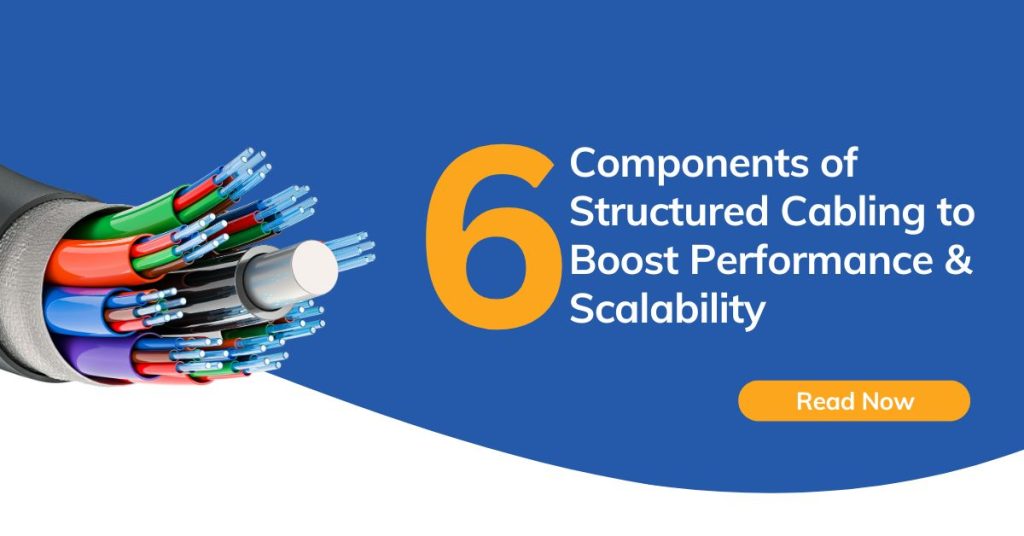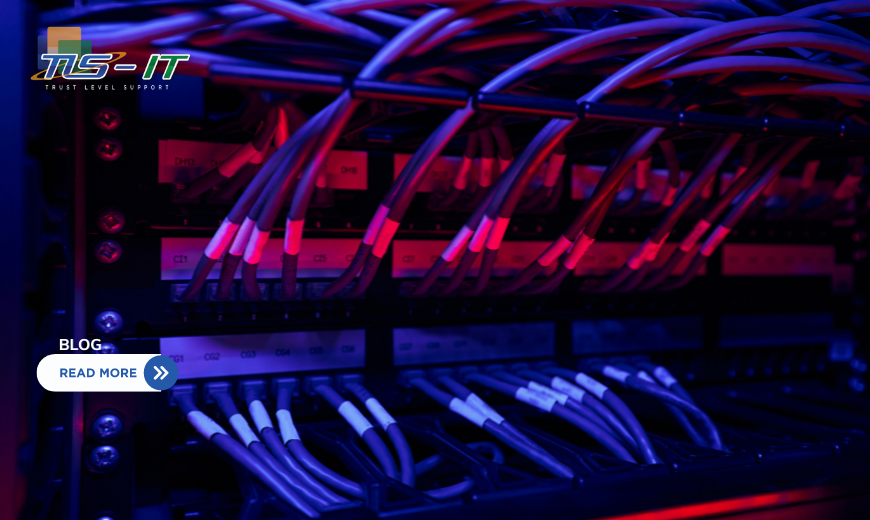In today’s business world, staying connected is of utmost importance for smooth operations and growth. The backbone of this connectivity lies in structured cabling installation—a process that weaves together wires, cables, and components to create a robust telecommunications infrastructure. In this blog, we’ll understand the importance of structured cabling, exploring its significance, best practices, and common pitfalls.
What is Structured Cabling?
Structured cabling refers to a standardized approach of organizing and installing cables that support multiple hardware uses and provide a comprehensive telecommunications infrastructure within a building or campus. It encompasses the design and installation of a network cabling system that supports various communication technologies, such as data, voice and video, ensuring seamless connectivity throughout an organization.
Structured cabling uses a well-organized layout of cables, connectors, and hardware components. It follows specific industry standards and best practices to ensure reliability, scalability, and ease of maintenance. This approach allows for easier management and troubleshooting of network issues, as well as facilitates future upgrades and expansions as technology evolves.
Structured Cabling: The Backbone of Modern Communication
Structured cabling is more than just a network infrastructure—it’s a strategic investment in the seamless flow of information within an organization. Unlike traditional point-to-point cabling, structured cabling is organized into subsystems, each serving a specific function in the network architecture. This systematic approach improves performance, reliability and offers scalability and flexibility.
Facts and Figures: According to recent industry reports, the global structured cabling market is projected to reach a value of over $15 billion by 2026, driven by the increasing demand for high-speed data transmission and the proliferation of IoT devices in various industries.
Tips for Successful Structured Cabling Installation
Start with a Solid Plan: Planning acts as the base for successful structured cabling installation. Consider your current needs and future growth projections to design a scalable and future-proof infrastructure. Selecting the right cable type is crucial, ensuring compatibility with evolving technologies.
- Unified Transmission: With the advent of VoIP and cloud-based communication systems, integrating voice and data transmission over the same cable has become not only feasible but advantageous. Utilizing the same cable for both purposes streamlines installation and maintenance while optimizing resource utilization.
- Prioritize Maintenance: Proper maintenance is essential to preserve the integrity and performance of your cabling infrastructure. Invest in cable management tools, implement color-coded labeling for easy identification, and conduct regular inspections to detect and address potential issues proactively.
- Electromagnetic Separation: To minimize interference and ensure signal integrity, keep structured cabling separate from electrical cables. Magnetic fields generated by electrical cables can disrupt data transmission, leading to network disturbances and performance degradation.
- Adhere to Standards: Compliance with industry standards such as TIA/EIA-568 is paramount to ensure interoperability and reliability. Following established guidelines not only ensures consistency in installation but also facilitates seamless integration with third-party systems and equipment.
- Stay Informed: Technology is ever-evolving, and staying abreast of the latest trends and advancements is essential for optimizing your cabling infrastructure. Regularly educate yourself and your team on emerging technologies and best practices to future-proof your network.
Structured Cabling Installation: Pitfalls to Avoid
While structured cabling offers numerous benefits, certain pitfalls can jeopardize its effectiveness and longevity. Here are some common mistakes to steer clear of:
- Lack of Planning: Rushing into installation without a comprehensive plan can lead to inefficiencies, compatibility issues, and costly rework down the line. Take the time to strategize and consult with experienced professionals to develop a tailored cabling solution.
- Poor Cable Management: Neglecting proper cable management can result in tangled wires, impedance mismatches, and increased risk of damage. Invest in cable trays, racks, and labeling systems to maintain a tidy and organized infrastructure.
- Non-Compliance: Ignoring regulatory requirements and industry standards not only compromises performance but also exposes your organization to legal liabilities. Ensure compliance with relevant codes and regulations to mitigate risks and ensure a compliant installation.
- Environmental Neglect: Failure to consider environmental factors such as temperature and humidity can lead to premature cable degradation and system failures. Install cables in controlled environments and implement measures to safeguard against environmental hazards.
- Inadequate Testing: Thorough testing is essential to validate the integrity and performance of your cabling infrastructure. Skipping or skimping on testing can result in undetected issues that manifest later as costly downtime and service disruptions.
Structured Cabling Installation Checklist
Pre-installation:
- Plan and strategize the installation, considering current needs and future growth.
- Select appropriate cable types and equipment vendors.
- Coordinate with relevant stakeholders and obtain necessary permits.
- Ensure all safety protocols are in place and communicated to the installation team.
During installation:
- Monitor progress and address any issues promptly.
- Conduct thorough testing to validate performance and compliance.
Post-installation:
- Document and finalize the installation details for future reference.
- Conduct periodic maintenance and inspections to ensure ongoing reliability.
- Improve Your Connectivity with Structured Cabling
Structured cabling installation is not just about connecting wires—it’s about building a foundation for seamless communication and collaboration. By adhering to best practices, avoiding common pitfalls, and staying informed about industry advancements, you can create a robust and future-proof network infrastructure that empowers your organization to thrive in the digital age.
At TLS-IT, we specialize in designing and implementing tailored structured cabling solutions that align with your unique requirements and objectives. Contact us at (+971) 43955877 for configuration assistance. Our experts are available 24/7 to help you. With over 10 years of experience in configuration and reselling, we guarantee top-notch service and support.




